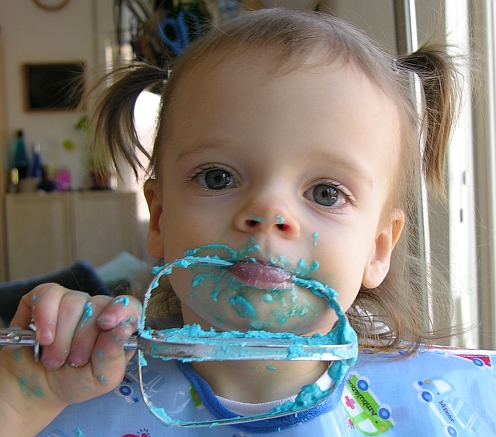
My Mum Makes Cakes!
Discworld Tutorial - Orc Head Tutorial - Shelob Tutorial - Gummy Tutorial - Gallery - Books - Links

My Mum Makes Cakes!
Decorating cakes in artistic ways is rewarding both for the artist and the recipients. Not only do you get to enjoy doing the craft and its resulting aesthetics, but you can eat it too!
Sculptural sugarcraft frequently uses a type of icing called sugarpaste (or rolled fondant) made out of mostly powdered (confectioner's) sugar with a tiny bit of liquid added. I've used several recipes over the years but over time have adapted several and now make my own fondant as follows:
Put the cold water in a microwave-safe dish and sprinkle the gelatin over the top evenly and quickly. Allow the gelatin to rest for a couple of minutes until it has absorbed all the water. Meanwhile, measure the corn syrup in a microwave-safe container (I just use my pyrex measuring cup) and warm it in the microwave for a few seconds. Do not overheat it, but get it above body temperature. If you are colouring the whole batch of fondant, add your gel-based colour to the corn syrup now and mix thoroughly.
Similarly warm up the gelatin mix until it turns into a mostly-clear liquid. Add it to the corn syrup and mix.
Place about a third of the sugar in a mixer with a sturdy paddle attachment (ours is metal, I have never tried with plastic and can't vouch for its strength for this application). Pour the liquid mixture into the bowl and mix at the lowest speed, gradually adding the rest of the sugar as each addition is incorporated. Toward the end, it will not mix fully and some dry clumps of sugar will remain at the bottom of the bowl.
Liberally dust a large work surface with powdered sugar and turn out the contents of the bowl. I like to use a bowl scraper to get it all out and off of the paddle quickly. Knead until smooth, adding more powdered sugar if necessary depending on ambient humidity, temperature, etc.
Store wrapped in plastic and then in a zipper-lock thick plastic bag for up to about a month or two, depending on climate, or stored in the freezer for several months. If it gets a little too dry, wet your hands lightly before kneading it thoroughly again.
As you mix/knead, or if you've had the sugarpaste in storage, warm it up in the microwave for a few seconds (and I really mean a few, like 5 at a time, or it'll melt and be awful!). That'll make it easier to work with.
Avoid using liquid food colouring, as it turns the sugarpaste to goo. If you cannot find colouring paste at a craft or cake shop near you and must use liquid food colouring, I have found that you can avoid the gooey problem by premixing the liquid colour with a bit of powdered sugar. Put the amount of colour you intend to use in a small mixing bowl, then add powdered sugar slowly and mix, continuing to add until the mixture is a thick paste. This does thin the colour somewhat, but you can always add more later.
I find that it's much easier to add colour to the wet mixture BEFORE putting that into the powdered sugar. This yields a much more uniform colour more easily than repeated kneading. If you're going for bold colours, add LOTS of your gel colour to the wet mixture so that it is a dark version of the colour you want. The sugar will lighten the colour, so don't be stingy or you'll just end up having to knead in more after anyway.
These directions are generalized for all cakes. Some cakes will require more or fewer of these steps, or additional steps not mentioned.
For a step-by-step example of how to build an advanced cake, see the Discworld cake page or the orc head cake page. For photos of how I've made some cake stands using PVC pipe, see the Alien Film Festival cake Wolverine cake pages.
Discworld Tutorial - Orc Head Tutorial - Shelob Tutorial - Gummy Tutorial - Gallery - Books - Links
Use this link to view this page with my preferred colour and font settings.
Page last updated April 28, 2011.
Email me at crafts@kimberlychapman.com
If you want to receive notification of updates on any portion of this site, simply enter your email address here and click/select the button to enter. You will be required to sign up for a free Yahoo! account to complete registration. Please note that Yahoo!'s privacy policy and other management are outside of kimberlychapman.com's responsibility. Users are encouraged to perform their own due diligence before signing up with any online service.
To find out more about the list or read messages without signing up, please visit the Yahoo! page for the kimberlychapman updates mailing list.
For more information on what these tags mean, please see About KimberlyChapman.com.